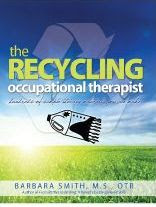The Tripod Grasp, as the name implies involves grasping a writing tool using three fingers, which likens it to the three-legged device that stabilizes a camera. The tripod grasp is considered the most efficient for pencil control and endurance. However, developing the tripod grasp is a gradual process beginning with fine-motor activities that strengthen the "tripod fingers"- the index, middle fingers and thumb.
Typically developing children between 1 and 1 1/2 year grasp a pencil inside the palm. Between 2 and 3 years of age they begin grasping it with all the fingers and thumb facing downward. By 3 years of age they typically begin grasping near the pencil point between the index and middle fingers and thumb- forming a tripod. Over the next years of practice the tripod grasp refines so that the pencil is held with greater precise and control.
Strengthening the "Tripod Fingers"
1) Pushing pennies or buttons into a slot in container lid or opening in a tennis ball
2) Pushing pegs into a Lite Brite Board
3) Removing tiny objects from putty or clay.
4) squeezing clothes pins or chip clips. The little girl in the photo is removing squeeze pins from a horse's mane.
5) Use of tongs to pick up small objects, the game Operation uses tongs.

One of the easiest strategies is to provide thick, short crayons to grasp. The child will have to grasp using the fingers as opposed to grasping a marker inside the palm. Wiping a dry erase board with a small rag and erasing pencil marks with a kneeded eraser also strengthen the tripod fingers.

The following videos demonstrate a few of my home made manipulation tasks that strengthen the "tripod fingers". But there are also lots of activities and toys on the market that develop these skills. Here are a few more:
1) Dressing dolls with fasteners
2) Coloring with a small crayon over sandpaper or raised textures. It will take force to make the textures show up on the paper.
3) Weaving, lacing and stringing beads
4) Screwing/unscrewing nuts and bolts or containers with caps
5) Legos, Tinker Toys, Knex and other construction toys
7) ripping paper or fabric for arts and crafts projects
Source: Strengthening the Tripod Grasp Fingers by RecyclingOT
Source: Strengthening the Tripod Grasp Fingers by RecyclingOT
Source: Make-Your-Own Lacing Cord Activities by RecyclingOT
Working in the Vertical Plane
 One easy strategy that occupational therapists frequently recommend is to adapt activities to play and work on vertical surfaces. You can see in the above photo that the Lite Brite toy is perfect for this. Coloring and writing on vertical surfaces puts the wrist in the best anatomical position (wrist extension) for pencil control. Here are a few, fun vertical plane activities for young children:
One easy strategy that occupational therapists frequently recommend is to adapt activities to play and work on vertical surfaces. You can see in the above photo that the Lite Brite toy is perfect for this. Coloring and writing on vertical surfaces puts the wrist in the best anatomical position (wrist extension) for pencil control. Here are a few, fun vertical plane activities for young children:
1) coloring on a large, refrigerator size box
2) use of white and black, felt boards on the wall.
3) attach a Lego board to the wall
4) Paint on large easel or paper on wall
5) bathtub paint to use on tub walls
6) paint the house, shed or garage with water and brush
Source: Bottle Coloring and Erasing to Develop Pencil Control by RecyclingOT
Source: Recycling Occupational Therapist demonstrates Fidget Spinner by RecyclingOT







No comments:
Post a Comment